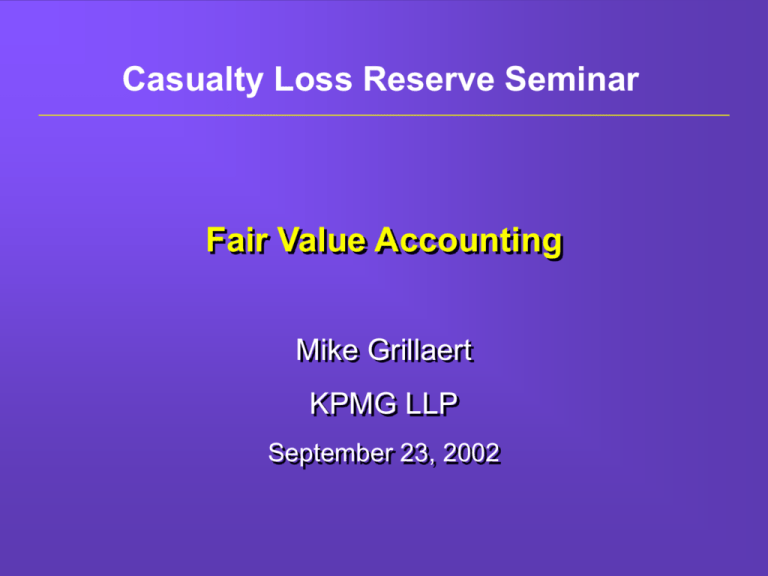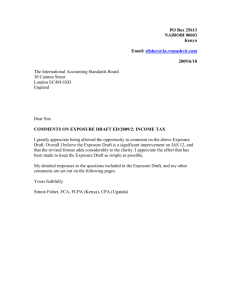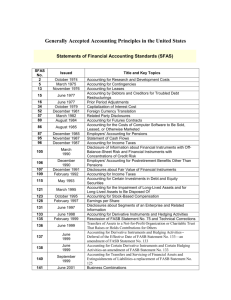Fair Value Accounting
advertisement

Casualty Loss Reserve Seminar Fair Value Accounting Mike Grillaert KPMG LLP September 23, 2002 Fair Value at the FASB FASB began fair value project in 1986 SFAS No. 107, Disclosures about Fair Value of Financial Instruments, issued in 1991 SFAS No. 115, Accounting for Certain Investments in Debt and Equity Securities, issued in 1993 SFAS No. 133, Accounting for Derivative Instruments and Hedging Activities, issued in 1998 FASB Concepts Statement No. 7, Using Cash Flow Information and Present Value Accounting Measurements, issued in 2000 A comprehensive Exposure Draft to come, but when??? Fair Value: The FASB’s Ultimate Goal Paragraph 334 of Statement 133 . . . The Board is committed to work diligently toward resolving , in a timely manner, the conceptual and practical issues related to determining the fair values of financial instruments and portfolios of financial instruments. Techniques for refining the measurement of the fair values of all financial instruments continue to develop at a rapid pace, and the Board believes that all financial instruments should be carried in the statement of financial position at fair value when the conceptual and measurement issues are resolved. Why Is Fair Value Relevant? Investors and Creditors are primarily interested in assessing the amounts, timing, and uncertainty of future net cash flows. Information is relevant if it helps with such an assessment. Information based on prices that reflect the market’s assessment, under current conditions, of the present values of the future cash flows is more relevant than information based on old market prices. What is Fair Value? Since December of 2001, the FASB has made the following decisions: Fair value of a financial instrument should be an estimated exit price—the price that would have been received or paid if it had been sold, exchanged, or settled on the measurement date. Commissions paid on acquisitions, originations, sales, incurrences, or settlements of financial instruments should not be included in the determination of fair value; they should be reported as expense in the period in which they are incurred. The effects of changes in an entity’s own creditworthiness and credit risk premium should be included in determining the fair value of that entity’s liabilities. Fair Value and Concept Statement No. 7 February, 2000—FASB issued Concept Statement No. 107, Using Cash Flow Information and Present Value in Accounting Measurements. Adopted expected value cash flow estimates rather than “most likely” best estimates. Adopted fair value as measurement objective when employing present value. Included impact of entity’s own credit standing in the measurement of its liabilities. Fair Value and Concept Statement No. 7 (cont.) Concept statement not an accounting standard, but used to develop new and revised accounting standards. Concept Statement has been controversial. FASB has issued 4 “Understanding the Issues” papers to explain its position. FASB’s Next Steps In March 2002, the Board temporarily suspended deliberations to focus on other, higher priority projects. In September 2002, the Board expects to recommence deliberations on the scope of the proposed standard. This issue includes: The definition of financial instruments Nonfinancial instruments that may be included in the scope Financial instruments that may be excluded from the scope Contracts that are very similar to specific financial instruments. FASB’s Next Steps (cont.) Other Issues to be addressed in the proposed Exposure Draft: Form and content of the required disclosure including presentation of changes in fair value Disclosure of other matters, for example risk exposures, measurement sensitivity, and valuation policies and methods. Brief History of IAS International Accounting Standards Board (IASB) has been working since the late 1980s to develop a financial reporting model for all companies. Framework completed in 1989 Standards (IAS) developed since then An insurance standard has not been issued Insurance project started in 1997 “Issues Papers” delivered in 1999 Draft Statement of Principles (DSOP) developed end of 2001 DSOP revision targeted for 2002, most likely end of 2003 Possible Insurance Contract Treatment The treatment described in the following slides are mostly the compilations of the thoughts surrounding the direction of IAS for insurance contracts. Most of the items look to the Draft Statement of Principles and also look to the general IAS Framework for consistency with IAS objectives. The final insurance contract accounting will likely differ from what is described herein and the differences could be significant. IAS Definition of Insurance Contract An insurance contract is a contract that exposes the insurer to identified risks of loss from events or circumstances occurring or discovered within a specified period, including death, survival (annuity), sickness, disability, property damage, injury to others, and business interruption. Deferral & Matching vs Asset/Liability Approach Asset & Liability Approach Deferral and Matching Supported in DSOP Not supported in DSOP Entity Specific Value Fair Value Under each method, total profit is the same, but the emergence of profit is markedly different Comparison of Methods Deferral & Matching • Emphasis on income statement • Expenses are deferred to match future income • Profit emerges over term of contract Asset & Liability • Emphasis on balance sheet • Profit or loss results from change in value of assets & liabilities • On initial recognition: provision for risk and uncertainty • No gain on sale • Possible gain on sale Entity Specific Value – IAS Approach Fair Value – FASB Approach • Value of asset/liability to the firm that holds it • May reflect factors not available or relevant to the market • PV = costs firm will incur in settling liability with PH/beneficiaries • Consistent with IAS 39 • Value for which asset/liability could be exchanged between knowledgeable persons in an arms length transaction. • PV = amount firm would have to pay a third party to assume liability. Asset/Liability - Entity Specific Valuation Value of Insurance Contract = PV (all future cash flows including policyholder dividends) Best estimate assumptions - Stochastic modeling techniques strongly implied - Probability weighted approach - Options measured using option pricing techniques - No reference to underlying assets (except variable) Market value margins (MVM) added to best estimate to adjust for risk and uncertainty. - How to determine the level of MVM is being heavily debated (level prescribed in insurance standard?, left to company to decide?, left to company to decide?) Discount rate should be the risk free rate. Impact for US Companies Which Companies are affected? - Companies listed on EU or Australian exchanges - Companies that report to EU or Australian parents - Companies that report to parents where the regulators are requiring IAS. - Companies that wish to compare to their peer group, where similar companies report on an IAS basis Conversions to IAS are expected to take two phases - IAS standards other than insurance, including IAS 39 work for insurance companies (by year end 2005) This work has already started at some companies -- now is the time to get large projects started - Insurance standard conversions once the standard has been set (estimated effective at year end 2007) FRR 60 – SEC Cautionary Advice Regarding Disclosure About Critical Accounting Policies Describe “critical” accounting policies MD&A should be balanced and responsive, and linkages to FS effects should be explained in plain English Audit committees should review accounting policy selection, application, and disclosure before finalization Proposed Rule – Critical Accounting Policies Proposed rule released May 10, 2002 Issued as follow-up to FRR 60 (still in effect) Would require a separate caption in MD&A section of annual reports, registration statements and proxy and information statements discussing critical accounting estimates and initial adoption of accounting policies What is Proposed Disclosure for Critical Accounting Estimates? For each critical accounting estimate: - identify and describe the estimate, assumptions and reasonably likely changes - Disclose significance to the financial statements and, where material, identification of the line items affected by the estimate; - identify and discuss segments affected by the estimate (if any); What is Proposed Disclosure for Critical Accounting Estimates? For each critical accounting estimate: - provide a quantitative discussion of the sensitivity of reported numbers to changes in estimates, either using possible changes in assumption(s) or a range of estimates; - a quantitative and qualitative discussion of the changes in estimates for the past three years; and - Disclose whether or not senior management has discussed the selection of estimates with the audit committee.






